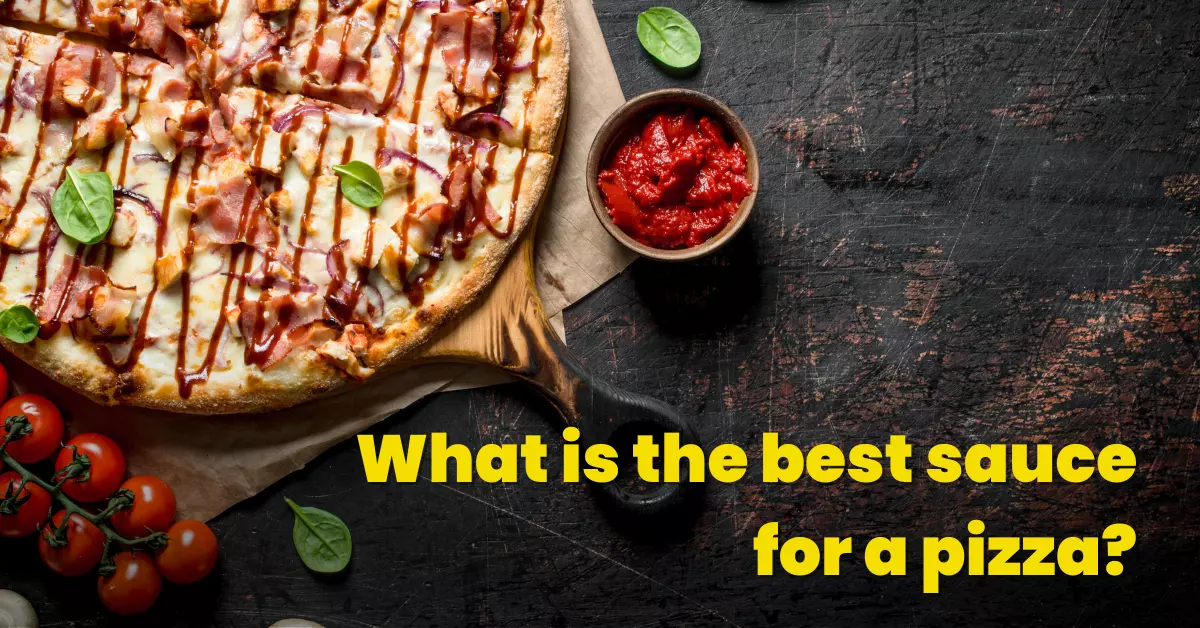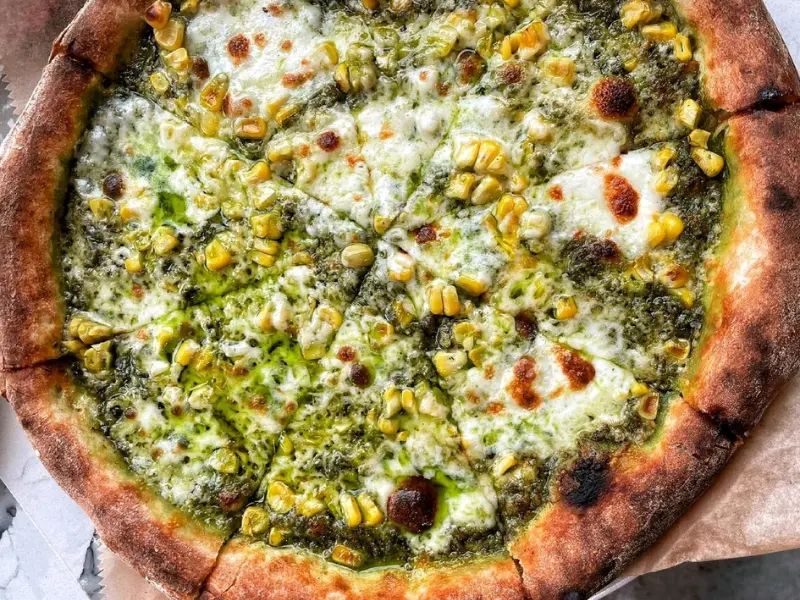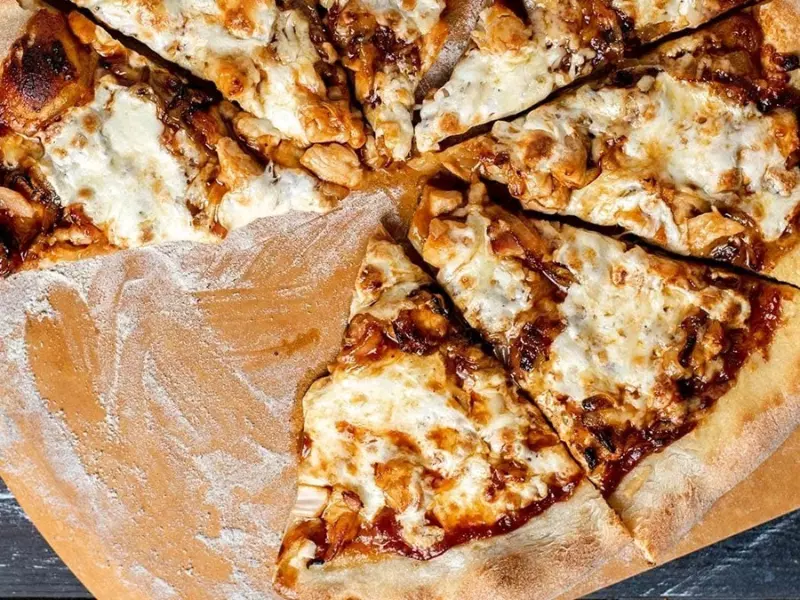What is the best sauce for a pizza?
This post may contain affiliate links. You can view our Affiliate Marketing Legal Disclaimer here.

Have you ever wondered what is the perfect sauce for a pizza? With so many different sauces out there, it can be daunting to determine which one will take your pizza to the next level.
From classic tomato to more innovative options, we’ll explore some of the most popular types of pizza sauces and answer the age-old question of which sauce is the best option for your perfect pizza creation.
What sauces can I use on a pizza?
The great thing about pizza is that it’s a very simple dish that can be used to highlight very different flavor profiles. This can be achieved by your choice of crust style, toppings, and of course what you choose as your sauce.
Let’s take a closer look at the most popular choices for pizza sauce and what makes them stand out.

Photo by @dough.the.evolution official Instagram. Classic Tomato Sauce on a Pizza Margherita
Classic Tomato Sauce
Close your eyes and think about a freshly baked pizza. I bet that the first things that popped into your mind were white mozzarella and red tomato sauce. That’s how iconic tomato sauce is on a pizza.
This sauce is also the most simple to prepare. Even though you can add plenty of herbs, and spices for flavor, a basic tomato sauce is just crushed tomatoes, salt, and a bit of oregano.
The simplicity of the sauce complements a wide range of flavors such as salty cured meats, fresh vegetables, and sweeter toppings like pineapple, or pine nuts.
When making pizza, you can never go wrong with good old classic tomato sauce.

Photo by @coastalcrust official Instagram. Coastal Crust’s Betty White pizza comes with White Wine Cream Sauce.
Creamy White Sauce
Creamy white sauce is made with butter, milk, garlic, flour, and Parmesan cheese. Pizza Bianca or white pizza is traditionally topped with mozzarella and olive oil, but this clean canvas is also perfect for earthy ingredients like fresh arugula, artichokes, and mushrooms.
The cheesy garlic flavor of this sauce also pairs very well with thinly sliced potatoes and rosemary. If you want to add meats, go for prosciutto, ham, or bacon (we love anything with bacon).
Creamy white sauce is not as versatile as tomato sauce on a pizza. A good tip to follow when making your white pie is to keep it simple. Choose your toppings wisely so they complement the sauce and not overpower it. Remember, in Pizza Bianca, the sauce is the real star of the show.

Photo by @themiamimenu official Instagram. Pesto Sauce has a nice bright and salty flavor.
Pesto Sauce
So you’ve seen pesto before on pasta, sandwiches, and pizza, but what exactly is pesto? Pesto originated in Genoa, Italy, and the word means “to crush”. This is because you make pesto sauce by crushing your ingredients with a mortar (or lightly blending in a food processor).
There are all kinds of pesto configurations but the traditional pesto sauce is made with pine nuts, basil, garlic, olive oil, and Parmesan cheese. Pesto is another sauce that packs a lot of flavors so you have to pair it with flavors that complement the heavy basil and garlic tones.
Our favorite toppings for pesto sauce pizza slices are Portabella mushrooms, sliced cherry tomatoes, sundried tomatoes, avocado, cashews, prosciutto, and goat cheese.

Photo by @skueche official Instagram. No sauce here. Pizza Bianca has an olive oil base.
Olive Oil or Pizza Bianca
This may surprise you but pizza as you know it today had its origin as a very different food. Pizza originated in the late 1700s in Naples, Italy, which was a Greek settlement. This place waterfront city was populated by many working poor who, among other things, ate flatbread covered with ingredients they could purchase from the local shops like olive oil tomatoes, cheese, garlic, and anchovies.
Also called Pizza Bianca, or white pizza, this pizza has no sauce just olive oil. The white moniker comes from the mozzarella cheese and clean appearance.
Only adding olive oil to your pizza lets you really taste the pizza dough and other toppings you add to your final creation. Olive oil is also very easy to infuse with different flavors like garlic, chilies, peppers, and herbs.

Photo by @kitchenswagger official Instagram. BBQ Sauce pairs well with salty meats and chicken.
BBQ Sauce
Last on our list is probably the most unconventional option out of all the sauces mentioned here. Most known for covering meats, chicken wings, or as a dipping sauce, BBQ sauce is a surprising flavor to add to a pizza.
There are literally thousands of different ways of making BBQ sauce but the core ingredients are ketchup, vinegar, brown sugar, paprika, salt, and pepper. BBQ sauce tends to be on the very sweet side and can easily overpower any other toppings you add to your pizza. That’s why the best toppings to choose for your BBQ pizza are ones that have very mild flavors like chicken, onions, and cilantro.
This is the best pizza sauce
The best sauce for a pizza is fresh homemade tomato sauce. Tomato sauce is the most traditional option in Italian cuisine. When done right, fresh tomato sauce can both keep your pizza moist and pair extremely well with more topping combinations than other sauce alternatives.
Keep reading to learn how to make fresh homemade tomato sauce for your pizzas.
How to make your own pizza sauce from fresh tomatoes?
Video by: Städler Made
Number one: Traditional pizza sauce, unlike pasta sauce, is not cooked. The cooking process evaporates some of the tomato juices. These juices will further evaporate while you’re baking your pizza making your sauce very dry and pasty. If you don’t precook your sauce, the tomato juices will help keep the pizza moist while it’s baking for a better-tasting pizza.
Number two: Unlike pasta sauce, pizza sauce is not the main focus of your pizza. Pasta sauces usually have lots of herbs, spices, and sometimes even vegetables for taste. Pizza sauce is much simpler so it pairs better with different flavor profiles. The simpler your sauce, the more creative you can get with the rest of your pizza toppings.
Ingredients
For this homemade tomato sauce recipe you only need four ingredients:
- 5 cups of fresh peeled and cubed tomatoes. You can also use 1-2 cans of peeled plum tomatoes.
- 1 teaspoon of salt.
- 1 teaspoon of dried oregano.
- A pinch of sugar.
Step 1: Crush your tomatoes.
Take your peeled tomatoes and crush them with your hands. You can also use a food mill or a hand blender on the lowest setting if you don’t want to get your hands dirty.
Remember that we want a very pulpy or chunky sauce. The tomato pulp will release more juice when your pizza is baking in the oven and keep your pizza sauce from drying out.
Step 2: Add the rest of the ingredients.
Tomatoes are naturally sweet, so we add salt to enhance that natural sweetness. Oregano just adds a more authentic Italian flavor to your sauce. Lastly, we add a pinch of sugar to balance the acidity of the tomatoes.
Step 3: You’re done!
There is no step 3. You’re actually done. Remember this sauce is very simple so you can highlight the rest of the flavors in your final pizza creation.
If you want a bit more flavor you can try adding some garlic or even red pepper flakes, but don’t overdo it. Remember, this is not a pasta sauce.
Which are the best store-bought pizza sauce alternatives I can use?
There are times when you just want a simple premade sauce so you can focus on the rest of your pizza creation. After extensive trial and error, as well as plenty of comparisons, there are 3 store-bought pizza sauces that we can confidently recommend you use.
Don Pepino Pizza Sauce. This pizza sauce has been loved by people for decades and it’s made in New Jersey with local Jersey-grown tomatoes. This tomato sauce has a milder taste and is perfect for pizza. It’s also used by many restaurants in their own pizzas. Check out Don Pepino Pizza Sauce here.
Red Pack canned crushed tomatoes. Many pizzaiolo use Red Pack for their creations and Red Pack sauce is the sauce to choose from if you’re looking for an authentic New York-style pizza experience. This sauce is made with local Southern California-grown tomatoes and the sauce has a very distinct sweet taste with very low acidity content. Check out Red Pack canned crushed tomatoes here.
We have a winner!
After trying out various sauces and conducting extensive research, it is safe to say that the search for the best sauce for a pizza is over. Fresh homemade tomato sauce with a hint of oregano is the clear winner providing the perfect balance of tanginess and sweetness to your final product.
However, it ultimately comes down to personal preference and taste. So go ahead, grab your sauce of preference, and create your own signature pizza! Happy cooking everybody!

ABOUT THE AUTHOR
I'm Rufino Rosado and my love for pizza has fueled a lifelong obsession. I've devoured countless slices, experimented with every style imaginable, and even endured my fair share of kitchen disasters. But through trial and error, I've transformed my passion into expertise, mastering the art of crafting restaurant-quality pizza at home. Now, I'm here to share my hard-earned knowledge and guide you on your own pizza journey, no matter your skill level.

Share this post!

ABOUT THE AUTHOR
I'm Rufino Rosado and my love for pizza has fueled a lifelong obsession. I've devoured countless slices, experimented with every style imaginable, and even endured my fair share of kitchen disasters. But through trial and error, I've transformed my passion into expertise, mastering the art of crafting restaurant-quality pizza at home. Now, I'm here to share my hard-earned knowledge and guide you on your own pizza journey, no matter your skill level.
